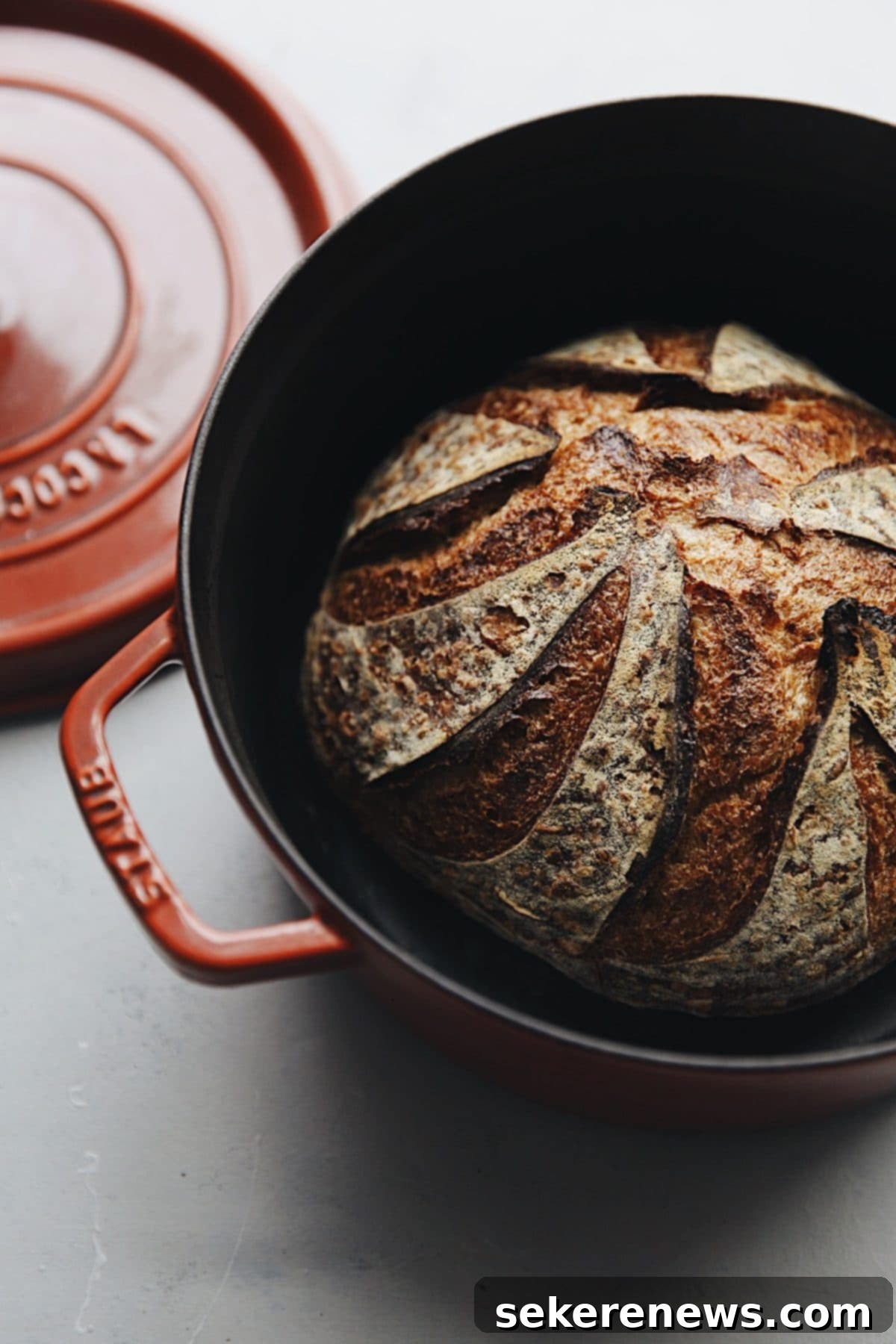Mastering Sourdough: Your Comprehensive Guide to Essential Tools and Resources for Home Baking
An extensive and updated guide to my favorite tools, equipment, and learning resources for baking delicious homemade sourdough bread. This guide is tailored for both aspiring and experienced home bakers.
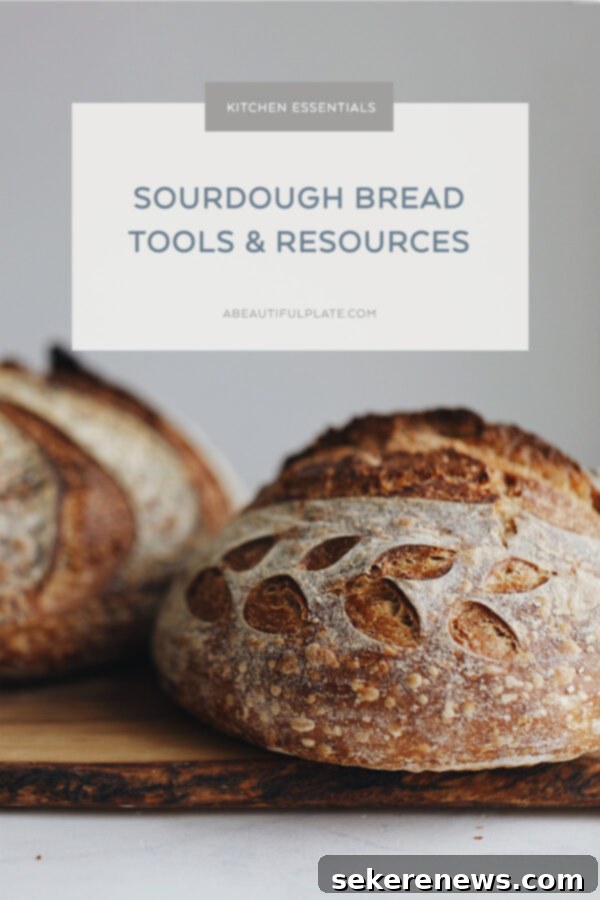
This definitive guide was originally published in October 2018 and has been thoroughly updated with fresh photographs, enhanced recommendations, and expanded content in February 2022 to ensure you have the most current and valuable information for your sourdough journey.
Each year, I meticulously craft a handful of culinary and baking goals, setting my sights on specific recipes and techniques that I’m eager to conquer and proudly cross off my gastronomic bucket list. This deliberate process serves as a constant source of inspiration, keeping my skills sharp, reinvigorating my profound love for cooking, and, most importantly, compelling me to slow down and truly immerse myself in the enjoyable, meditative process of creation.
In the past few years, one of my most ambitious and ultimately rewarding culinary quests has been to master the art of baking homemade sourdough bread. This ancient and fascinating fermented bread, crafted solely from naturally occurring wild yeast and bacteria, presented a unique challenge that I was eager to embrace. The idea of transforming simple flour and water into a living starter, and then into a magnificent, crusty loaf, was utterly captivating.
I had experimented with sourdough bread some time ago, even developing a nascent starter and attempting a few loaves. However, various life events, including extensive travel and demanding projects, frequently sidetracked my efforts, and the detailed process was never fully documented or shared. Despite these initial detours, the allure of sourdough remained a persistent whisper in my culinary aspirations.
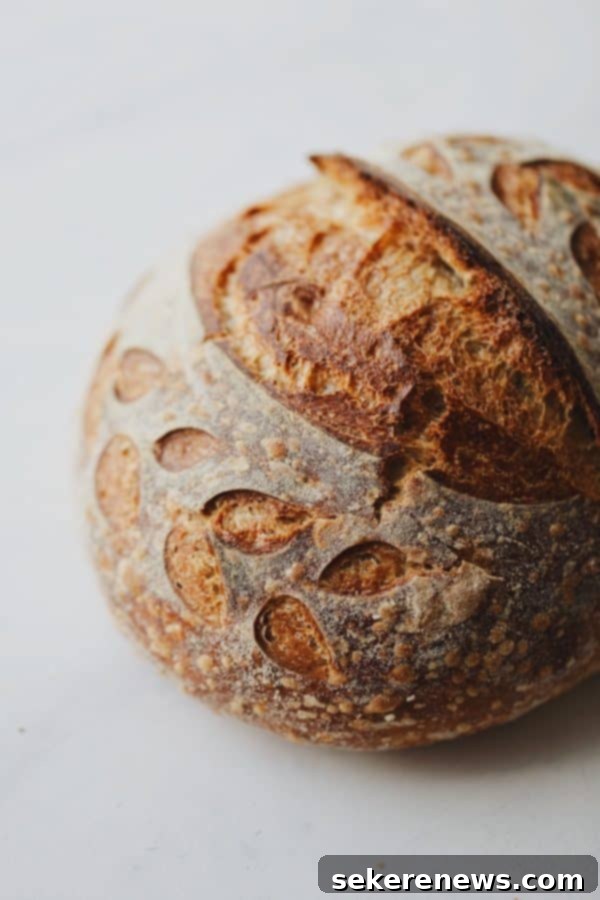
Then, in the vibrant summer of 2018, a spontaneous surge of inspiration struck, compelling me to pick up where I left off. My renewed passion was undeniably fueled by a magical trip to France, where the enchanting aroma of freshly baked bread seemed to waft from every boulangerie. It was upon my return that I definitively committed to nurturing my sourdough starter, giving birth to what would become the vibrant heart of all my future sourdough creations.
Today, I am the delighted owner of a thriving homemade sourdough starter, affectionately named Breadley Cooper. The entire journey, from its humble beginnings to its robust, bubbling activity, has been a constant source of fascination and immense reward. There is truly nothing quite as exhilarating as the moment you slice into a fresh, warm loaf of sourdough bread that you’ve created from scratch. This mastery has even extended beyond traditional loaves, enabling me to prepare incredible sourdough pizza at home. This profound satisfaction ignited an eager desire to share my recipes, detailed insights, and the entire captivating baking process with a wider audience.
Our Mission: My ultimate goal with this guide is to passionately encourage and deeply inspire every home baker, while simultaneously demystifying and simplifying the intricate process of sourdough baking, making it far more accessible and genuinely enjoyable for everyone.
I understand completely that the world of sourdough baking can initially appear rather intimidating. The specialized terminology often seems confusing, the precise techniques can be difficult to grasp, and the entire process can, at times, become exceptionally frustrating. Many aspiring bakers are daunted by the lengthy timelines, the perceived complexity, and the daunting fear of failure.
But, I wholeheartedly believe that armed with the right tools, reliable resources, and a healthy dose of patience, every single one of us possesses the innate ability to create truly amazing, artisanal sourdough bread right in the comfort of our own homes. This guide is specifically crafted to empower you, transforming those initial feelings of intimidation into immense pride and satisfaction with every perfect loaf you bake.
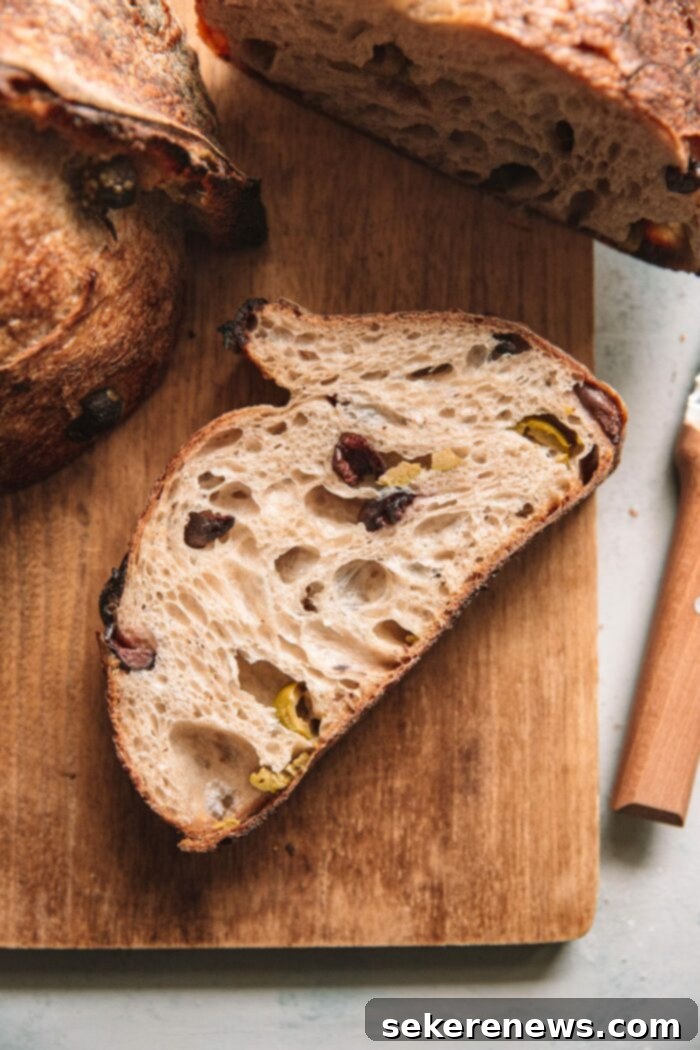
Before we enthusiastically dive into the rewarding world of baking, it’s absolutely crucial to have a thorough discussion about the must-have tools and equipment for sourdough baking. While it’s true that you can often improvise with various existing kitchen items, there are undeniably a few core essentials that you’ll want to acquire before your first bake. These specific tools will not only significantly streamline your process but also dramatically improve the consistency and quality of your homemade sourdough results.
In this comprehensive guide, you’ll discover an exhaustive and carefully curated list of my absolute favorite sourdough learning resources, indispensable cookbooks, and thoroughly tested sourdough bread tools. Each item has earned its place through repeated use and proven performance in my own kitchen.
I’ve meticulously structured this guide to be maximally helpful for everyone. You’ll find a dedicated section detailing the essential must-haves for beginners, ensuring you have the foundational equipment to start your journey with confidence. Furthermore, I’ve included a valuable list of incredibly helpful optional tools, perfectly suited for the enthusiastic and advanced home baker looking to refine their techniques, expand their repertoire, or simply make the entire process even more efficient and profoundly enjoyable.
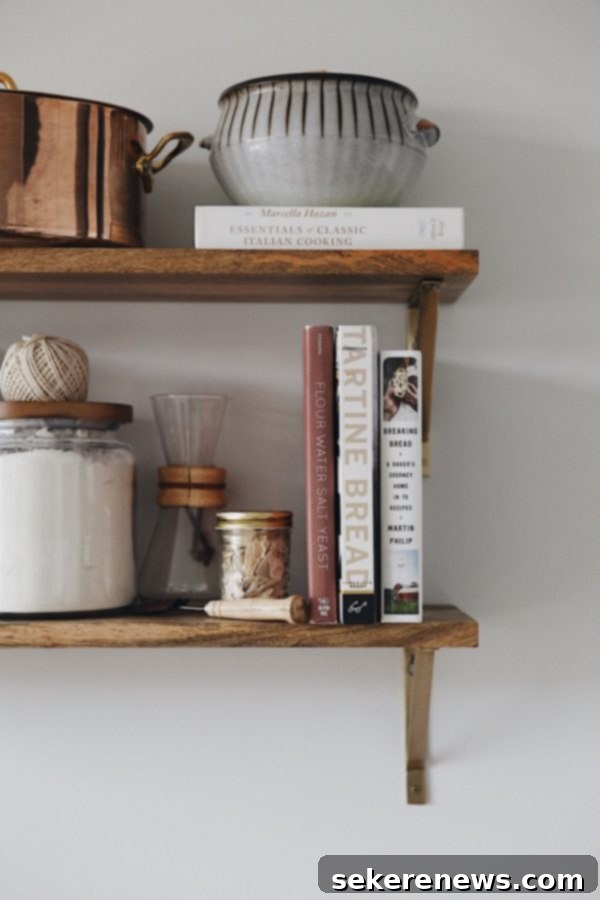
This post contains carefully selected affiliate links. Should you choose to purchase an item through any of the links provided below, I may receive a modest commission at absolutely no additional cost to you. Your valued support plays a significant role in helping me continue to provide high-quality, free content like this guide!
Important Note Before Getting Started: While this post is intentionally lengthy and packed with detailed information, please do not feel deterred or overwhelmed by the comprehensive list of items. In reality, there are only a few truly required tools necessary to bake delicious sourdough bread at home. This extensive list is designed to share all of my thoroughly tested and highly recommended favorites, encompassing both the fundamental essentials and several optional tools that will undoubtedly make the entire process easier, more enjoyable, and ultimately yield even more satisfying results.
For more in-depth guidance and to navigate any potential challenges on your sourdough journey, be sure to explore my other dedicated Sourdough Resources. These include my invaluable Sourdough Starter Troubleshooting Guide, which helps address common issues with your active starter, and the essential Sourdough Bread Baking Troubleshooting Guide, designed to assist you in overcoming any hurdles you might encounter during the actual baking process. These guides are your secret weapon for consistent success!
Favorite Sourdough Cookbooks & Essential Learning Resources
Embarking on the sourdough journey is significantly enriched by access to high-quality information. Investing in reliable reference materials can dramatically accelerate your learning curve and deepen your understanding. Here are some of my top recommendations, ranging from foundational texts to excellent modern online platforms, each offering unique value to the aspiring sourdough baker:
Tartine Bread – A bona fide classic in the pantheon of artisan baking literature, Tartine Bread by Chad Robertson is an utterly indispensable addition to any serious bread baker’s cookbook collection. Its pioneering focus on natural leavening, meticulous techniques, and stunning photography has inspired countless home bakers worldwide. With that said, for absolute beginners, it is often most effectively utilized in conjunction with other, more explicitly detailed resources. The initial sourdough starter guide and some of the classic bread recipes can be quite concise, frequently assuming a certain level of foundational baking understanding. Furthermore, its characteristic long-format recipes, while comprehensive, may occasionally prove challenging to follow for those entirely new to the craft. Despite these nuances, the book is absolutely brimming with a wealth of profound information, invaluable insights, and advanced techniques for those prepared to thoroughly immerse themselves in its pages. It truly is a masterclass in bread theory and technique.
Flour Water Salt Yeast – Ken Forkish’s Flour Water Salt Yeast consistently ranks as one of my all-time favorite bread cookbooks. It masterfully draws inspiration from the revered Tartine bread method but elevates it with a significantly greater level of detail and clarity, particularly concerning recommended tools, essential equipment, and the underlying scientific principles of baking. The recipes within are remarkably easy to follow, a tremendous advantage for beginners, and often include practical, thoughtfully laid-out sample baking timelines – an invaluable feature when you’re coordinating a multi-day fermentation and baking schedule. It is worth noting, however, that the majority of bread recipes in this comprehensive cookbook do utilize commercial yeast (either instant or active dried yeast), with only a limited selection being pure levain (sourdough starter) recipes. Nevertheless, it provides an exceptional and robust foundation in artisan bread baking, even if your ultimate goal is to transition fully into sourdough.
The Perfect Loaf – Maurizio Leo’s website, The Perfect Loaf, is, without a doubt, one of the most outstanding online resources available for sourdough bread baking. It is an absolute treasure trove, meticulously packed with detailed sourdough recipes that are accompanied by exceptionally thorough explanations and clear, step-by-step process photos. These visuals are incredibly helpful for understanding and executing each intricate stage of the bake. This is, in fact, the precise method that I personally employed and found the most consistent success with when developing my own vibrant sourdough starter. If you’re hesitant to invest in physical cookbooks or simply prefer comprehensive digital resources, this website is an unparalleled, free alternative that you should absolutely bookmark and consult frequently on your baking journey.
Baker Bettie – My incredibly talented friend, Kristin Hoffman, shares an equal, fervent passion for sourdough bread baking, and she has diligently curated an incredible wealth of educational resources on her website. I wholeheartedly recommend exploring her fantastic YouTube channel. It is particularly beneficial if you are eager to gain a deeper, more profound understanding of the ‘why’ behind specific baking techniques and the fundamental scientific principles at play. Kristin is an exceptionally wonderful and engaging teacher, possessing a remarkable ability to simplify complex concepts and make them accessible to bakers of all experience levels.
The Bread Baker’s Apprentice – While this award-winning cookbook by the esteemed Peter Reinhart is not exclusively focused on sourdough, it stands as an extraordinarily helpful and foundational resource for anyone aspiring to delve deeply into the art of bread baking. If your primary goal is to truly comprehend the intricate ‘whys’ of bread making – from the complex role of gluten development to the nuanced science of fermentation – this book is an invaluable companion. It is densely packed with crucial information, covers essential baking science fundamentals, and provides master formulas for an impressive and diverse array of breads, ranging from classic boules and chewy bagels to rich, buttery brioche. It establishes a robust theoretical foundation that beautifully complements any sourdough practice, preparing you for advanced techniques.
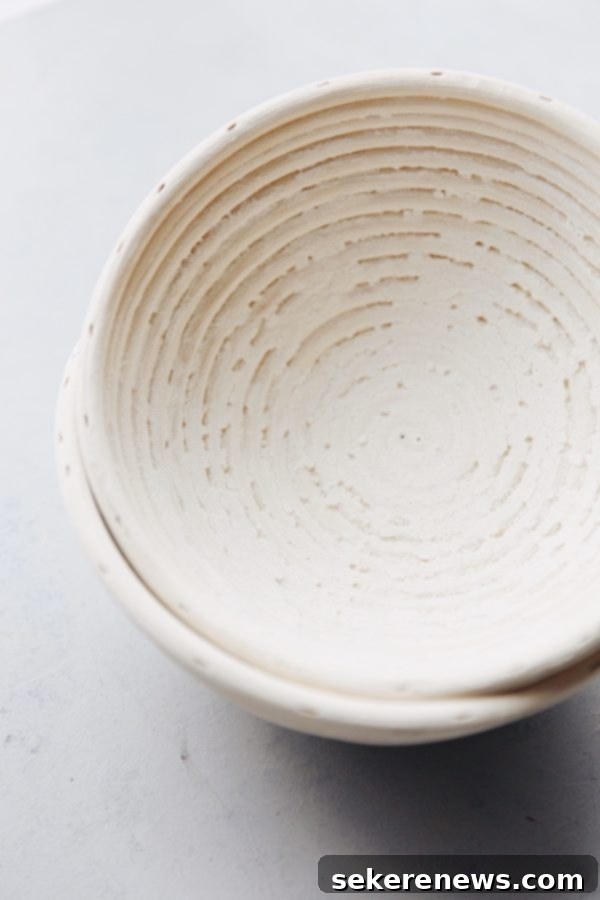

Artisan Sourdough Made Simple – While this particular cookbook is not part of my personal library, I have consistently received glowing reviews and outstanding feedback about its content. It is widely heralded as an exceptional resource for beginners, frequently praised for its refreshingly clear, approachable instructions and streamlined recipes that make the seemingly complex world of artisan sourdough bread baking feel entirely manageable and enjoyable. If you’re just embarking on your sourdough journey and seeking a welcoming, unintimidating entry point, this cookbook comes highly recommended as a superb initial investment to build your confidence and skills.
Bread – Jeffrey Hamelman’s monumental work, Bread, is an incredibly extensive and profoundly detailed cookbook, making it an ideal, almost encyclopedic choice for seasoned or professional bakers. It is specifically designed for those who have already mastered the fundamental techniques and are eager to gain a far deeper, more nuanced understanding of the intricate bread-making process, including a vast array of sophisticated European-style breads and advanced methodologies. For beginners, however, I would strongly advise first building a solid foundation with some of the other more accessible and specialized cookbooks mentioned earlier in this list before moving on to this comprehensive, advanced resource. This book represents a deeper journey into the craft, not the starting line.
Breaking Bread – This delightful cookbook, a thoughtful and much-appreciated gift from King Arthur Flour, is skillfully penned by their esteemed head bread baker. It presents an incredibly diverse and inviting collection of recipes, spanning a wide range of breads to tempting desserts. Within its pages, you’ll discover everything from perfectly crafted bagels and flaky biscuits to comforting pies and an array of other delectable treats. While it is not exclusively dedicated to sourdough, it does contain valuable, easy-to-follow instructions and provides a broad, accessible overview of general bread-making techniques. For someone just beginning their broader bread-baking journey, it offers a solid and encouraging introduction. However, if your primary and immediate goal is to dive specifically and deeply into sourdough, I would recommend prioritizing several other specialized sourdough cookbooks mentioned earlier in this list before acquiring Breaking Bread.
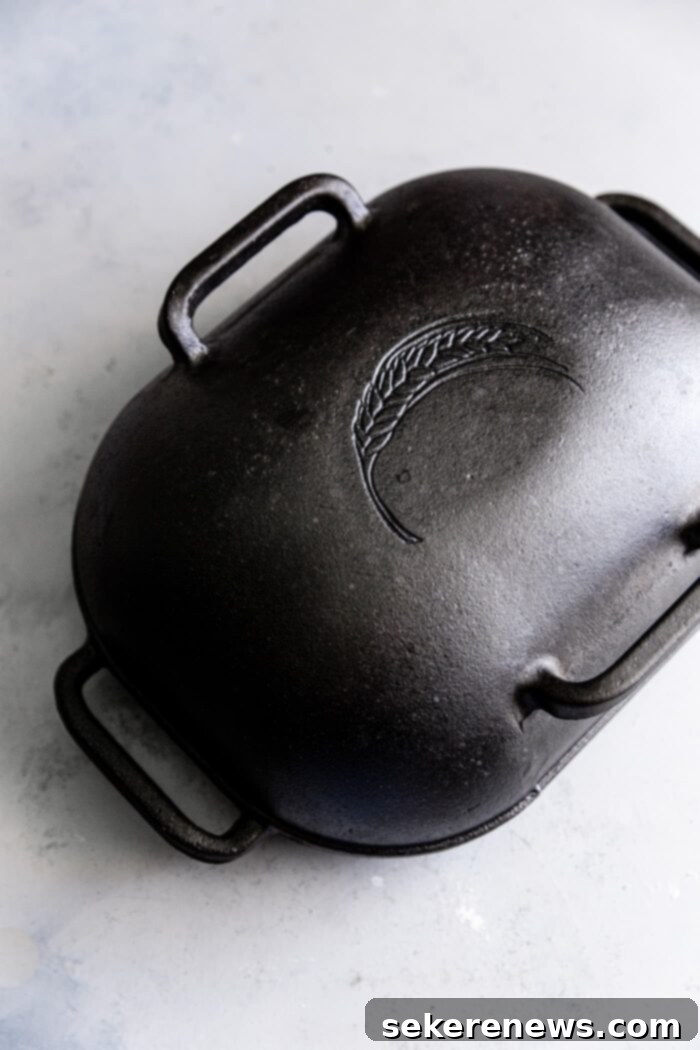
Must-Have Sourdough Tools & Equipment for Every Baker:
To truly excel in sourdough baking and consistently achieve those coveted, professional-level results, certain tools transcend mere convenience and become absolutely indispensable. These carefully selected items are specifically designed to simplify complex processes, significantly enhance dough development, and ensure a high degree of consistency and quality in every loaf you bake. Here are the tools I consider essential for any serious home baker, from novice to expert:
Challenger Bread Pan – This is, without a shadow of a doubt, my absolute favorite bread baking tool, and if you are genuinely interested in baking sourdough regularly and with outstanding results, I cannot recommend it highly enough. While it certainly represents a significant initial investment, the Challenger Bread Pan fundamentally transforms the baking process into an incredibly easy and seamless experience. Its robust, heavy cast-iron base and lid are meticulously engineered to beautifully trap both heat and essential steam. This controlled environment is critically important for achieving superior oven spring (the final rise in the oven) and developing that coveted, deeply crusted, flavorful exterior. What truly sets it apart is its thoughtfully designed shallow base, complete with integrated handles. This innovative design allows for incredibly easy and safe transfer of your delicate dough into the searing hot pan, completely eliminating the need for cumbersome parchment paper slings. Furthermore, the Challenger’s unique, elongated shape offers remarkable versatility, enabling you to bake not only perfect boules (round loaves) but also elegant batards (oval loaves – my personal preferred shape for its ease of slicing and aesthetic appeal), demi baguettes, and more. Beyond its primary function for bread, the robust cast-iron base can even double as a versatile pan for stovetop cooking, adding to its overall utility and value in your kitchen.
Cast Iron Dutch Oven – A high-quality cast iron Dutch Oven is another fantastic and widely accessible option for baking sourdough, and chances are, you might already have one proudly displayed in your kitchen. These culinary workhorses are wonderfully multi-purpose and incredibly versatile across a wide range of cooking tasks, making them a wise and foundational investment for any home chef. While they are perfect for baking beautifully round sourdough loaves with excellent steam retention, it’s important to note that most standard round Dutch ovens aren’t ideally designed to accommodate oval (batard) shaped loaves. When selecting a Dutch oven specifically for bread baking, aim for a size of 5-6 quarts; this capacity is typically ideal for most standard sourdough loaf sizes, providing ample space for optimal dough expansion without being overly cumbersome to handle. I personally have a particular fondness for Staub Dutch ovens due to their exceptional heat retention, even heating, and renowned durability, but Le Creuset is another classic, highly respected brand that promises a lifetime of reliable and beautiful use in your kitchen.
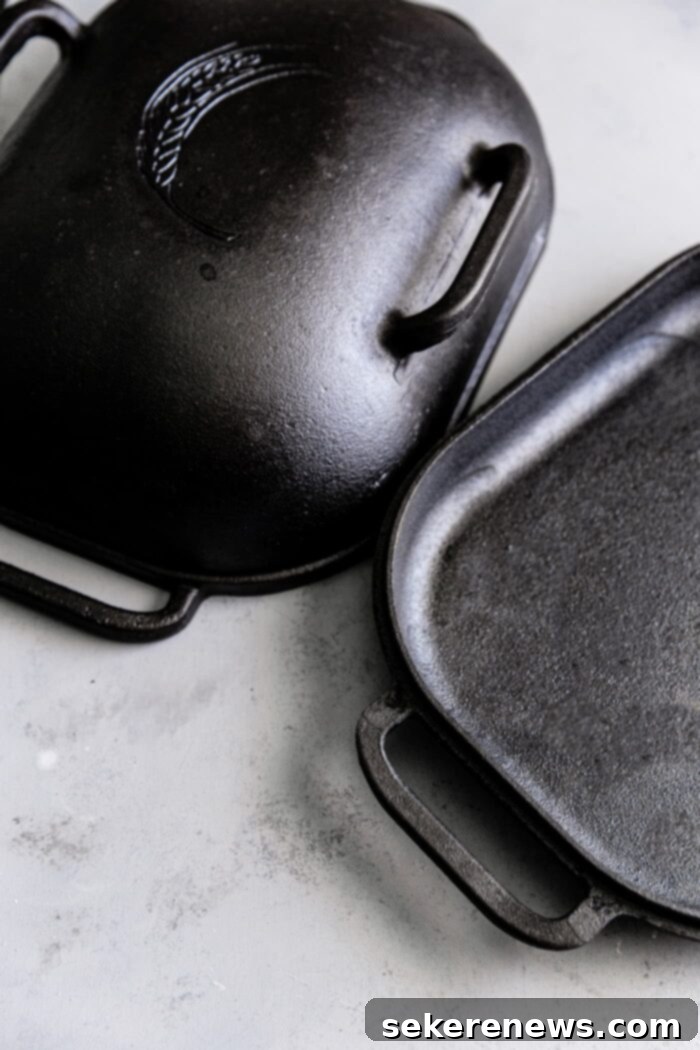
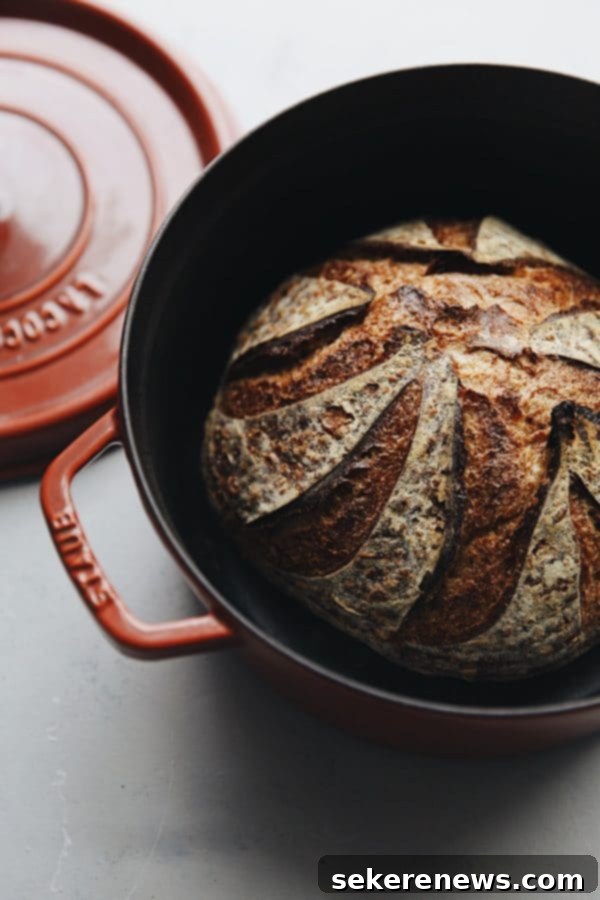
Combo Cooker – A fantastic, versatile, and often more affordable alternative to a traditional Dutch oven, the combo cooker essentially functions as an inverted Dutch oven. It ingeniously features a cast iron lid that also serves as a shallow base, which can double as a convenient stand-alone skillet. This makes a combo cooker an absolutely excellent choice if you’re navigating a tighter budget and the premium Challenger Bread Pan is currently out of reach, or if you simply don’t own or wish to purchase a dedicated Dutch oven. Its clever design significantly simplifies the critical dough transfer process into the searing hot cooking vessel, a common challenge for new bakers seeking that perfect oven spring without risking burns or deforming their carefully shaped loaf.
Essential Equipment Note on Steam: While it is technically feasible to bake bread directly on a baking steel or stone, these methods typically necessitate additional, often intricate techniques for effectively creating and trapping sufficient steam within your conventional oven. This can frequently be cumbersome, less reliable, and prone to inconsistency, especially for beginners who are still mastering the nuances of sourdough. Steam is an absolutely critical element for achieving that desirable crispy, beautifully blistered crust – the unmistakable hallmark of truly great artisan sourdough loaves. Baking in a contained, high-heat environment, such as the Challenger Bread Pan or a good quality Dutch Oven, addresses this crucial need perfectly by efficiently trapping the steam released naturally from the dough, consistently leading to superior and more predictable results.
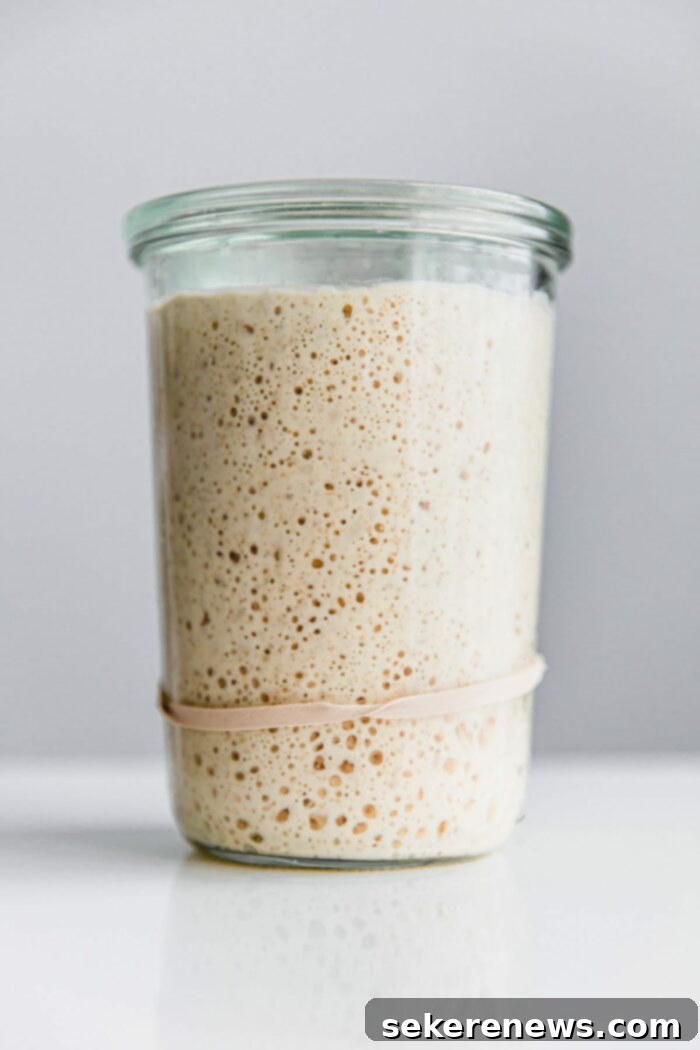

26 Ounce Weck Jar or Basic Straight-Sided Glass Container – For successfully cultivating, maintaining, and observing your precious sourdough starter, a suitable container is absolutely paramount. When choosing, it’s vital to prioritize a glass container that meets these key criteria: 1) it must be effortlessly easy to clean, ensuring optimal hygiene for your living starter and preventing unwanted buildup; 2) it should ideally come with a lid that is not entirely airtight, allowing for essential airflow during proper fermentation without causing the starter to dry out; and 3) it unequivocally needs to be appropriately sized, providing ample room for your starter to be scaled up as needed and, crucially, allowing for its natural, vigorous growth, which can be up to four times its initial height during peak activity. My top recommendation for both functionality and aesthetics are straight-sided Weck Jars, particularly the 26-ounce size, celebrated for their ideal shape and robust quality. However, a thoroughly cleaned, repurposed glass jar (such as a pickle or jam jar) with straight sides can also serve the purpose perfectly well. I personally keep several on hand, including smaller sizes for everyday feeding and maintenance routines, which offers great flexibility. Challenger Breadware also thoughtfully sells elegant starter jar sets, though these are typically offered at a higher price point. As a simple yet remarkably effective visual aid, I highly recommend placing a rubber band around your jar to clearly mark the starter’s initial level after feeding, allowing you to easily track its impressive activity, significant growth, and eventual peak over time – a crucial indicator of its health and readiness.
Digital Baking Scale – A high-quality digital baking scale is not just a helpful gadget; it is an absolutely essential, non-negotiable tool for precise and successful bread baking. Sourdough recipes, in particular, rely heavily on accurate gram measurements to ensure consistent hydration levels and precise ingredient ratios, which are critical for predictable outcomes. Developing a familiarity with gram measurements and deeply understanding baking percentages (baker’s percentages) will not only significantly elevate your consistency but also profoundly increase your overall success as a bread baker. Furthermore, embracing a scale empowers you to confidently customize, adapt, and even develop your own bread recipes to your exact liking as your skills progress, giving you ultimate control and creative freedom over your dough and its final characteristics.
Instant-Read Thermometer – Throughout the various meticulous stages of sourdough bread making, accurate temperature measurement is unequivocally crucial. This ranges from ensuring your water is at the optimal temperature for feeding your precious starter to precisely checking the internal temperature of your freshly baked loaf for perfect doneness. I wholeheartedly and without reservation recommend investing in a superior quality Thermapen Instant-Read Thermometer; its unparalleled speed, pinpoint accuracy, and robust construction will quickly make it an indispensable, versatile tool for countless kitchen tasks far beyond just bread. However, for those just starting out, a basic yet reliable instant-read thermometer will certainly suffice to provide the necessary temperature readings and get you started on your baking journey.
Parchment Paper – If you’re primarily utilizing a standard Dutch oven for baking your sourdough loaves, keeping a roll of good quality parchment paper on hand is highly recommended as a practical aid. It serves a vital purpose in simplifying the potentially tricky dough transfer process. I personally find this simple parchment paper sling technique incredibly effective for safely and easily lowering your delicate, proofed dough into a preheated, scorching hot pan. This technique minimizes any risk of burns and, crucially, helps prevent misshaping your beautifully formed loaf, ensuring it maintains its structure during the critical initial moments of baking.
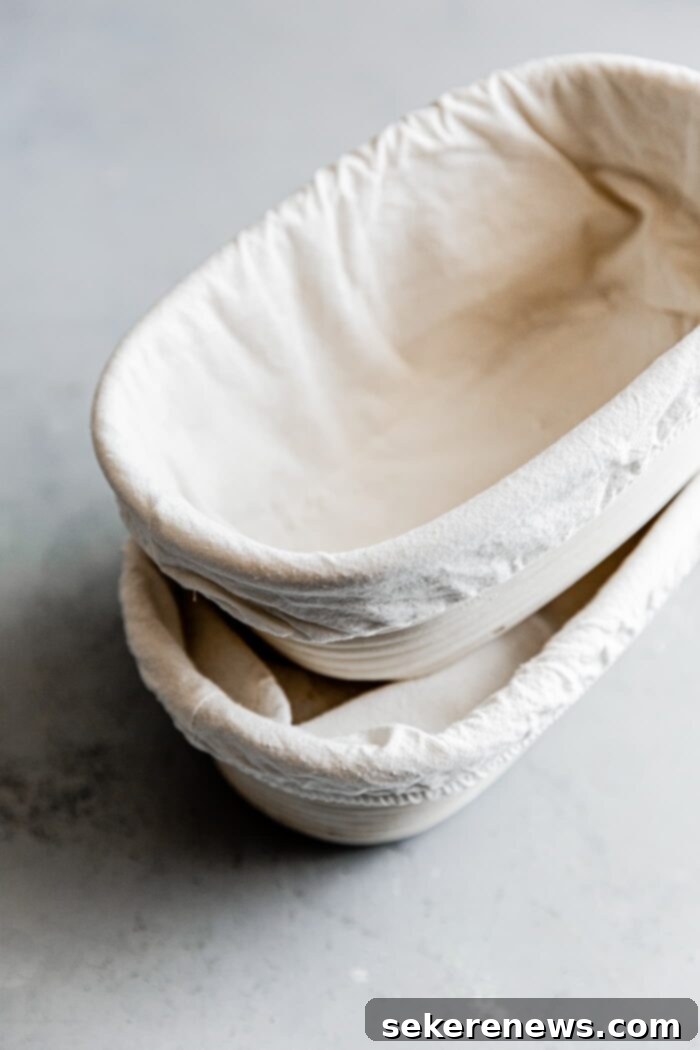
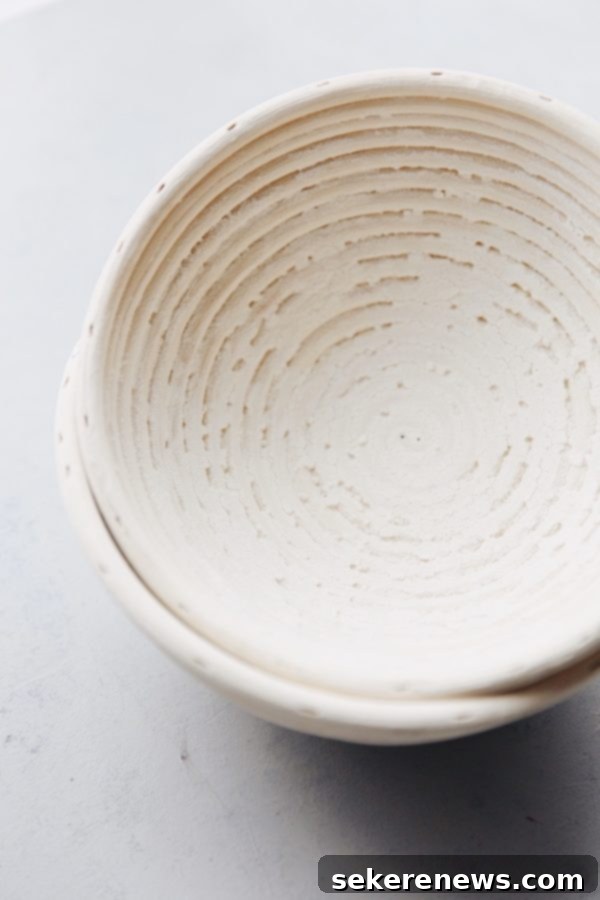
Banneton Baskets or Mixing Bowls with Linen Towels – Bannetons, also widely known as brotforms or proofing baskets, are traditional natural cane baskets specifically engineered to proof and gracefully hold bread dough as it develops its final, desired shape just before baking. The naturally porous cane material plays a crucial role by helping to absorb any excess moisture from the surface of the dough, which significantly contributes to the development of a drier, crispier crust and allows for more pronounced, beautiful scoring. These essential baskets are readily available in a wide variety of sizes and shapes to perfectly match your desired loaf aesthetic. It is important to choose bannetons that allow your dough to expand comfortably and fully during its final proofing stage. For optimal versatility in your baking, I highly recommend acquiring both 8 or 9-inch round bannetons for classic boules and 10-inch or 11-inch oval bannetons for elegant batards, depending on the dimensions and capacity of your chosen baking vessel (e.g., Dutch oven or Challenger pan). Owning two bannetons is particularly advantageous as it allows you to prepare and bake two loaves simultaneously, significantly enhancing the efficiency of your baking sessions. If you’re just starting out or wish to experiment with sourdough before making a dedicated investment, you can easily improvise by lining standard mixing bowls with clean, tightly woven kitchen linens that have been generously dusted with flour (preferably white rice flour to prevent sticking).
Bench Knife – A simple yet incredibly versatile bench knife is one of my most cherished and frequently utilized everyday kitchen tools, extending far beyond just bread baking. For sourdough, it becomes an absolutely indispensable aid for a multitude of tasks: it’s perfect for cleanly shaping and dividing bread dough without tearing or excessive handling, efficiently scooping up chopped ingredients from your cutting board, and quickly cleaning off sticky dough residue from your countertops. Its rigid blade and comfortable handle make dough handling a breeze. I personally prefer bench knives with comfortable rubber handles, as they can be conveniently and hygienically tossed into the dishwasher for effortless cleanup.
Flexible Bowl Scraper – Often overlooked and underestimated, flexible bowl scrapers are remarkably affordable and surprisingly helpful for various intricate stages of sourdough preparation. Their pliable yet sturdy nature makes them perfect for efficiently scraping down the sides of mixing bowls, ensuring no precious dough is left behind, and for gently folding and mixing bread dough during the crucial bulk fermentation process. They are also wonderfully gentle enough that they won’t scratch or damage your valuable mixing bowls, making them a safe and effective choice for any baker.
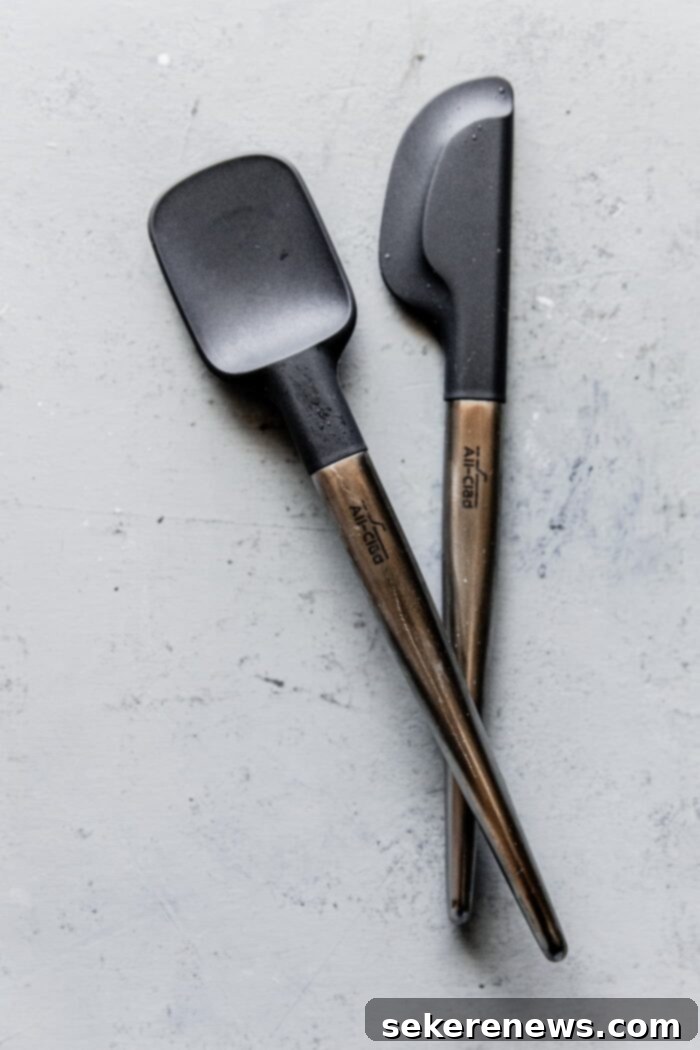
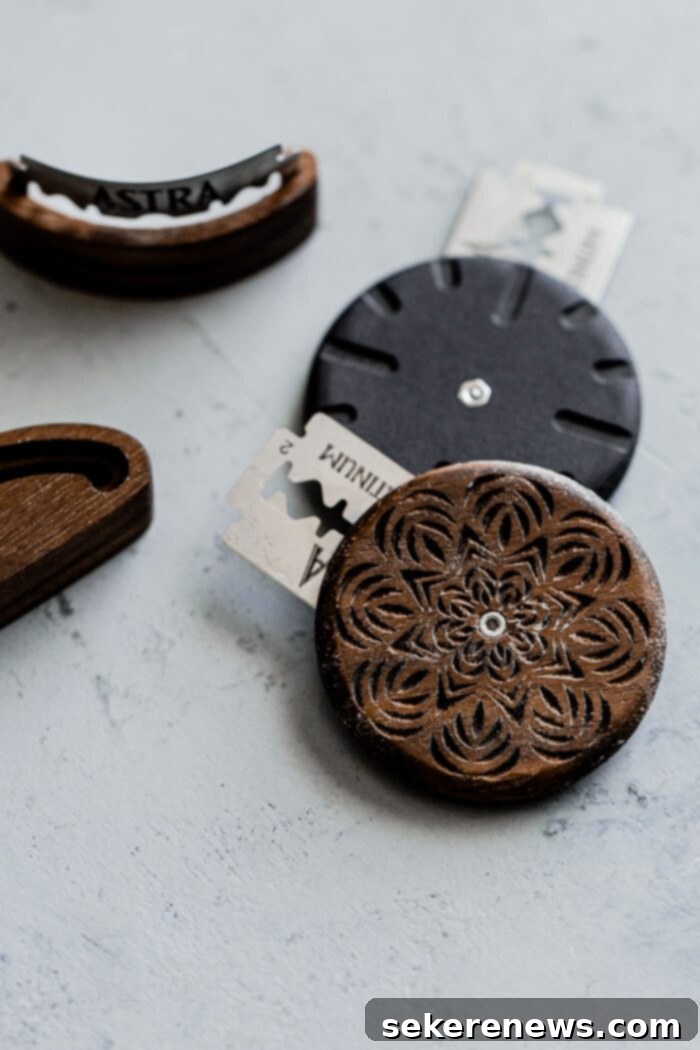
Small Spatula – While not strictly a rigid requirement, a small, durable rubber spatula proves incredibly useful, if not indispensable, especially for the delicate tasks of mixing and maintaining your sourdough starter. Its ideal size and flexible head allow for incredibly thorough mixing of flour and water, ensuring there are no dry spots that could hinder fermentation, and for easily scraping down the sides of your starter jar after feeding. This helps minimize waste and keeps your jar clean. OXO offers a solid and reliable option that is widely available. Personally, I particularly adore this set of All-Clad spatulas; their perfect size and ergonomic shape make them exceptionally well-suited for precisely mixing and scraping every last bit from a starter jar, ensuring maximum efficiency.
Long Serrated Bread Knife – A good-quality, long (ideally 9 to 10-inch) serrated bread knife is an absolutely essential tool for anyone baking bread at home, and it becomes particularly crucial when dealing with the robust, crusty exterior of sourdough loaves. Its sharp, scalloped edge is meticulously designed to allow you to effortlessly slice through tough crusts and tender interiors without crushing or tearing the delicate, airy crumb within. Beyond its primary function for bread, it’s a versatile workhorse for many other kitchen tasks, such such as slicing tomatoes or carving roasted meats, making it an undeniable must-have in any well-stocked culinary arsenal. For those seeking an excellent balance of quality, performance, and affordability, Mercer produces a highly regarded budget-friendly option that performs admirably alongside more expensive counterparts.
Bread Lame – If your aspiration is to create those stunning, professional-looking bread ‘ears’ or intricate decorative scores on your sourdough loaves, a dedicated bread lame (pronounced ‘lahm’) is an indispensable tool. This specialized scoring tool is crucial for controlling the expansion of your dough during baking, leading to beautiful artistry and superior oven spring. I have personally owned and rigorously tested many different lames over the years, and this particular WireMonkey Lame stands out as my absolute favorite (special note: readers of A Beautiful Plate will receive an automatic 10% discount when utilizing these specific links!). Its ergonomic size and comfortable shape make it exceptionally easy to hold and maneuver, allowing for incredibly precise and confident scoring, while its incredibly sharp, replaceable blades ensure clean, effortless cuts every time. While you can technically improvise with a very sharp utility knife, a pair of sharp kitchen scissors, or even craft a makeshift lame using a wooden coffee stirrer and a single-edge razor blade, a steady, well-made lame will undoubtedly make the job significantly easier, quicker, safer, and result in consistently superior aesthetic outcomes for your sourdough masterpieces.
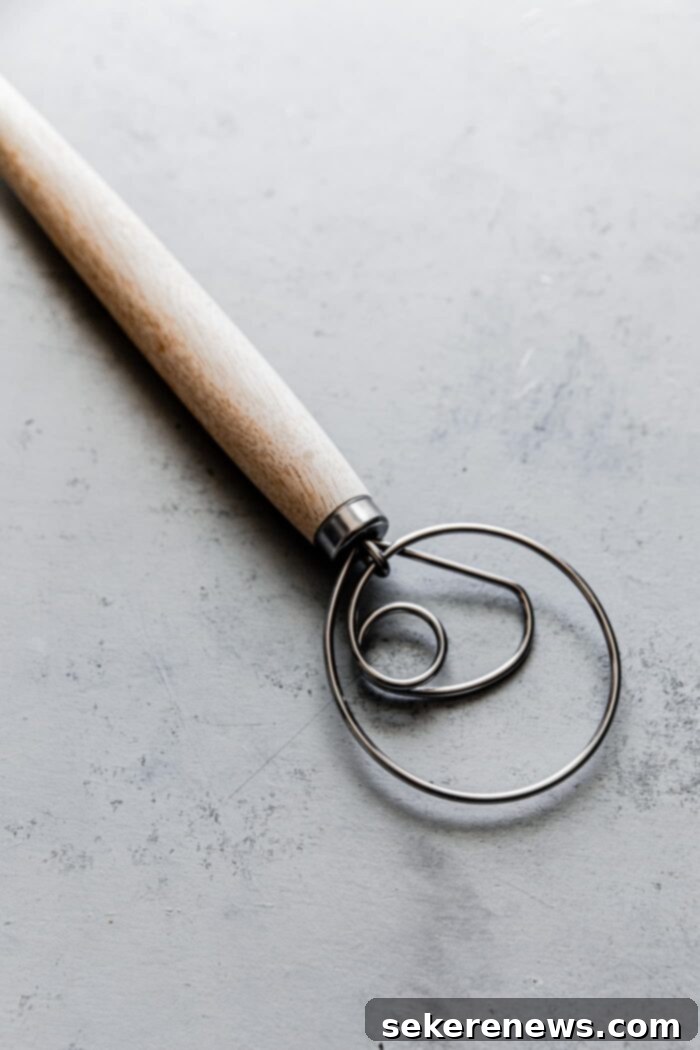
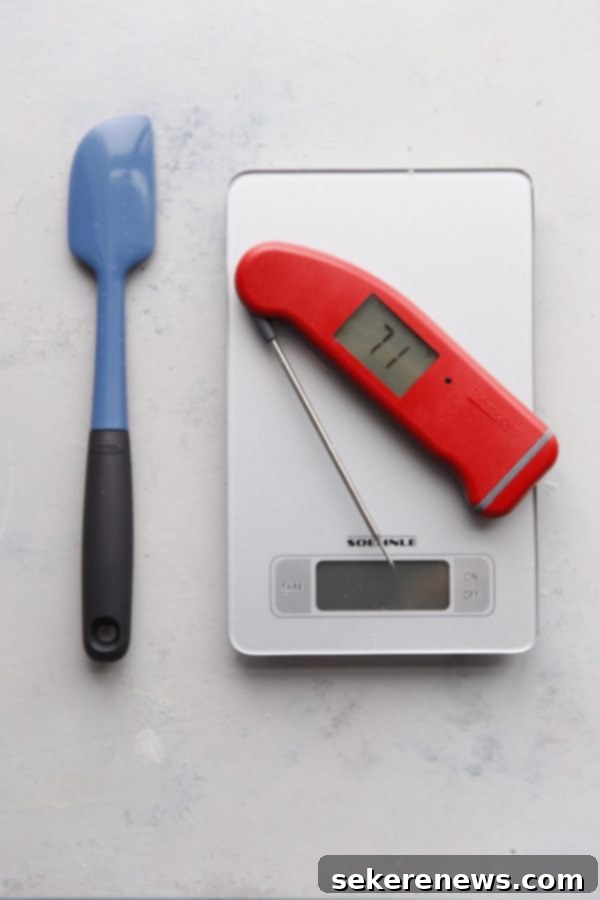
Other Highly Recommended Tools to Enhance Your Sourdough Baking:
While the previous section meticulously covered the absolute essentials for successful sourdough baking, these additional tools can further streamline your process, minimize mess, and significantly enhance your overall baking experience, especially as you become more confident and passionate about the craft.
Danish Dough Whisk – If you’re looking to significantly minimize mess and make the initial mixing of your dough a considerably smoother and more efficient process, a Danish dough whisk is an exceptionally helpful tool. Its unique, open spiral shape is ingeniously designed to prevent sticky dough from clumping and adhering excessively, making it far easier to thoroughly incorporate ingredients and then effortlessly clean afterward, especially when compared to a standard spoon or rubber spatula. Beyond its prowess with sourdough, I frequently find myself reaching for it to mix various other doughs, such as those for light and airy sourdough pizza, flaky biscuits, and delicate pastries, demonstrating its remarkable versatile utility in any active kitchen.
White Rice Flour – While regular wheat flour can certainly be used for dusting, white rice flour is a demonstrably superior choice for sourdough baking, and here’s precisely why: it is considerably less absorbent than regular wheat flour and, crucially, it is naturally gluten-free. These characteristics combine to make it an excellent option for generously dusting your banneton baskets or proofing bowls, creating a consistently non-stick surface that effectively prevents your delicate, high-hydration dough from adhering during its critical final proofing stage. This ensures a clean, effortless release of the dough and contributes to a beautifully shaped loaf every single time. The Bob’s Red Mill brand is widely available in most grocery stores and comes highly recommended for its consistent quality and reliability.
Ambient Thermometer – Understanding and meticulously controlling the temperature of your baking environment is an absolute cornerstone of consistently successful bread baking, particularly when working with sensitive sourdough starters and doughs. An ambient thermometer becomes an incredibly helpful, if not essential, tool, especially if your home or kitchen frequently experiences significant temperature fluctuations throughout the day or across different seasons. Temperature directly and profoundly influences the rate of fermentation, which, in turn, dictates many critical elements of the bread-making process, including the crucial baking timeline, the final flavor development, and the overall texture of your loaf. Knowing the precise ambient temperature of your space – whether it’s where you store your starter, proof your dough, or perform bulk fermentation – provides invaluable insight, allowing you to proactively adjust your timings and techniques for more consistent, predictable, and ultimately superior results in your sourdough endeavors.
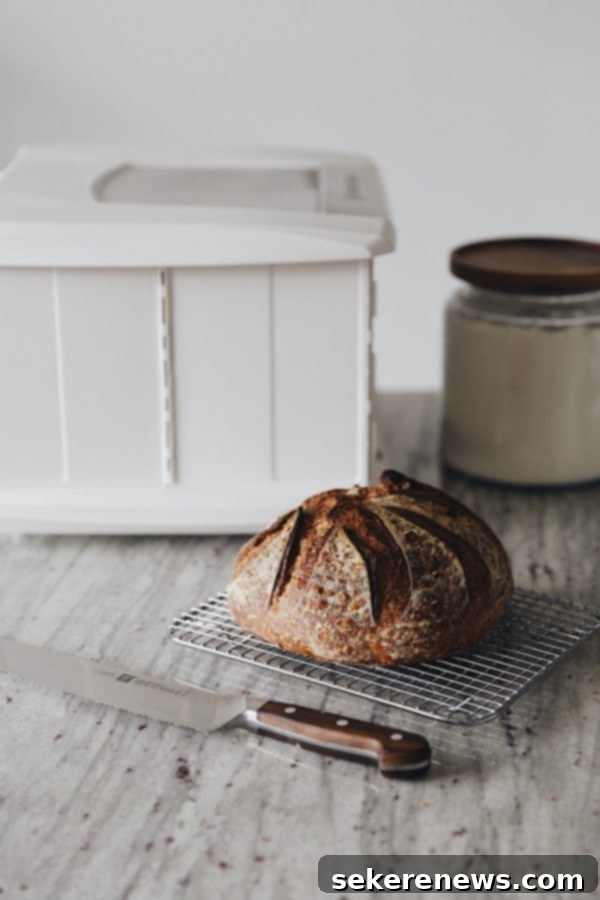
Splurge-Worthy Tools for the Dedicated & Advanced Sourdough Baker:
For those who have deeply embraced the sourdough journey and are eager to achieve truly professional-level consistency, unparalleled control, and experiment with more advanced techniques, these tools represent a significant yet undeniably worthwhile investment. While they are not strictly necessary for baking good bread, they will profoundly elevate your craft and open up new possibilities in your kitchen.
Brod and Taylor Proofing Box – This is arguably the ultimate bread-baking tool if your ambition is to take your sourdough bread baking to the absolute next level and establish a perfectly controlled proofing environment. If your home or kitchen frequently experiences dramatic temperature fluctuations, which can wreak havoc on consistent fermentation, you will undoubtedly adore this tool. It eliminates all guesswork by providing a stable, consistent temperature and a humid environment. Beyond its primary function for bread, its remarkable versatility truly shines, allowing you to meticulously explore other homemade fermented foods with precision, such as kombucha, yogurt, tempeh, and even double as a gentle warmer or slow cooker for other culinary creations. This specific proof box offers an impressively wide temperature range, meticulously settable from 70°F – 190°F (21°C-88°C), and thoughtfully includes a dedicated water tray for precise humidity control, which is absolutely vital for optimal dough development and a perfect crust.
Personal Note: I personally made the significant decision to invest in a Brod and Taylor Proofing Box specifically to gain unparalleled and precise control over the fermentation process. This investment truly allowed me to push the boundaries of my bread-baking passion and achieve a new echelon of results. While it is certainly a financial splurge, it has unequivocally proven to be an incredibly valuable and transformative tool for meticulously managing flavor development, achieving perfect fermentation timing, and consistently controlling overall dough behavior, leading to remarkably predictable outcomes. Despite its advanced capabilities, the proofer is conveniently sized, roughly comparable to a small microwave, yet it is remarkably energy-efficient and can even be folded down flat for compact storage when not in active use. It’s also thoughtfully spacious enough to comfortably hold a sourdough starter, an active levain, and your primary dough simultaneously, making multi-stage baking a seamless and stress-free experience.
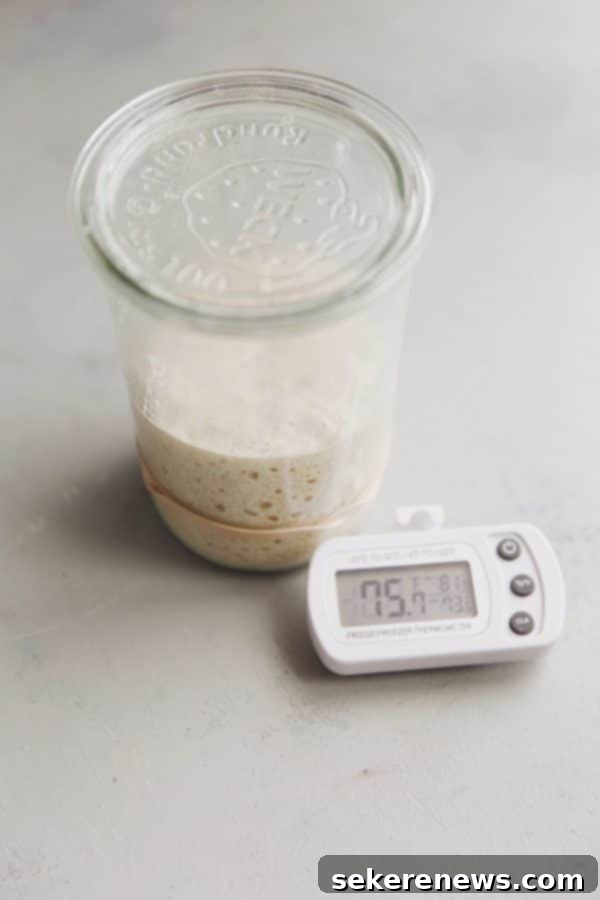

Baking Steel – It’s important to clarify that if you plan to bake your sourdough bread in a Challenger Bread Pan or a robust Dutch Oven, you generally do not need a separate baking steel or stone, as these enclosed vessels inherently provide their own steamy, high-heat environment. However, if you’re looking to branch out and explore baking different, open bread shapes (such as long baguettes or free-form artisan loaves) or wish to bake with more exposed steam injection methods, a baking steel becomes a truly wonderful and versatile addition to your kitchen arsenal. When it’s not actively being used for bread, a baking steel serves a fantastic secondary purpose: it radiates heat exceptionally evenly and consistently throughout your oven, providing a dependably hot surface that is absolutely perfect for baking other items like crisp pies, perfectly golden cookies, and especially fantastic, restaurant-quality sourdough pizza. Baking steels are widely considered superior to traditional baking stones in several key ways – they retain significantly more heat (making them ideal for achieving a super crispy pizza crust), they conduct heat far more efficiently, and they are considerably more durable and much easier to clean and maintain over time.
Have lingering questions about sourdough baking or any of the tools and resources mentioned in this guide? Please feel free to ask your questions in the comments section below, and I’ll be absolutely delighted to share my insights, offer assistance, and help you on your journey! For even more behind-the-scenes videos, daily tips, and a closer look at my ongoing sourdough bread-making process, be sure to follow along on Instagram. Happy baking, and enjoy the transformative magic of sourdough!
For a deeper dive into specific sourdough baking topics and to further equip your baking journey with comprehensive knowledge, be sure to explore the following invaluable resources:
- How to Dry Sourdough Starter (and Other Storage Methods) + How to Revive Dried Sourdough Starter
- Sourdough Starter Troubleshooting Guide
- Sourdough Bread Baking Troubleshooting Guide
- How to Store, Freeze, and Refresh Bread
- Artisan Sourdough Bread Recipe + Step-By-Step YouTube Video
- Sourdough Pizza Dough
